What is search intent & why does it matter?
14th Apr 2022

So, you’re trying to figure out how to bring more traffic to your website. Maybe you’ve done some keyword research, testing out what works the best. Tailored your content based on the keywords discovered. But the traffic coming through isn’t exactly what you’re hoping for. The queries are struggling to convert. The bounce rate isn’t going down, but you know for a fact it’s not your website design.
That’s about time where you discover what’s causing this and the culprit turns out to be – search intent. What does this SEO jargon mean & how can it help you build a high-quality traffic funnel moving forward?
Well, you’re in luck because we’re here to answer exactly that!
What is search intent?
Search intent is the goal of the user’s search query.
It’s what a person expects to find after typing in their query into a search engine. By now, all the biggest search engines organise information this way, rather than just by keywords. Making algorithms understand the meaning behind the content on a web page turns into a much more efficient way to organise information.
Let’s take ‘coffee’ as an example. Your search query will differ depending on what you’re looking to do with it. If you’re considering getting a cup of coffee while walking around – you would search for something like ‘coffee near me’. Whereas, if you’re trying to find out how to make coffee or where coffee comes from – your queries will vary.
Even though, all the topics revolve around ‘coffee’, you couldn’t be getting more different results.
Why is search intent important?
Simply put, Google cares about intent A LOT. Search intent becomes extremely important for any successful SEO activity. If a user searches for something but doesn’t find relevant answers, that signals Google that the search results are incompatible with the search query. And in turn, is not aligned with the webmaster guidelines.
So, if your content is not aligned with search intent – you will get punished from the SEO perspective. Let’s say you’re trying to find out how to take care of a specific type of plant, but the only results you’re getting are selling plants. It will feel quite annoying. That’s why search engines do their best to avoid that.
By understanding search intent & implementing good SEO practices, you can boost your organic traffic exponentially. Not only can it broaden your reach across the entire funnel, but it can also improve your website rankings.
Build your content strategy with search intent at the heart of it. Answering specific queries, from discovering your brand, to creating content around niche industry topics – this will allow you to reach more people.
In other words, create content that’s relevant to your audience. Make sure you answer the questions based on the correct search intent & employ a good linking strategy – making your content easily accessible to users and search engines alike.
Types of search intent
While on average, there are around 5.6 billion daily searches on Google (around 2 trillion a year) – they can all be assigned to the 4 main types of search intent.
- Informational Intent – looking for information/to learn something, for example: ‘what is Digital PR?’
- Navigational Intent – searching for a specific website, for example: ‘BBC website’
- Commercial Intent – looking to learn more before completing a conversion, for example: ‘best phone of the year’
- Transactional Intent – trying to complete an action/purchase, for example: ‘buy ASOS t-shirt’
If you take a closer look, the types of search intent resemble a buyer’s journey. For instance: How are running shoes made? (informational) -> the best running shoes 2022 (commercial) -> buy Nike running shoes (transactional/navigational)
User starts by learning more about the topic and goes on to research their choices, once a decision has been made – it’s time to convert.
Informational Intent
By far the biggest share of search queries is based on informational intent. In its essence, they are done to find information. Users are usually trying to learn something they don’t know. These queries tend to be in a form of questions, accompanied by ‘how to’, ‘guide’, ‘what is’, etc.
If the query is a precise question, like ‘who won premier league 2021’ – Google pulls out the answer into a snippet and places it at the very top of SERPs. So, you don’t need to click on any links.
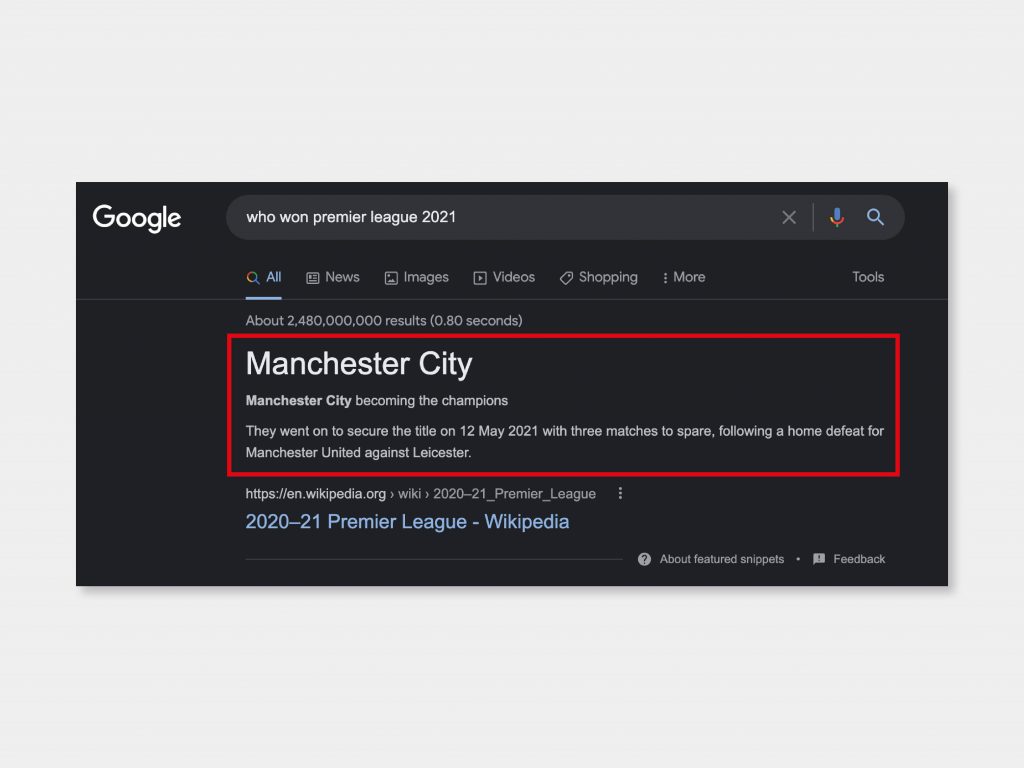
Alternatively, for the broader search queries, like ‘guide to SEO’, you will most likely see educational content from various sources. As well as the ‘People also ask’ section, which can prove to be quite useful to answer similar questions, that users didn’t think of asking.
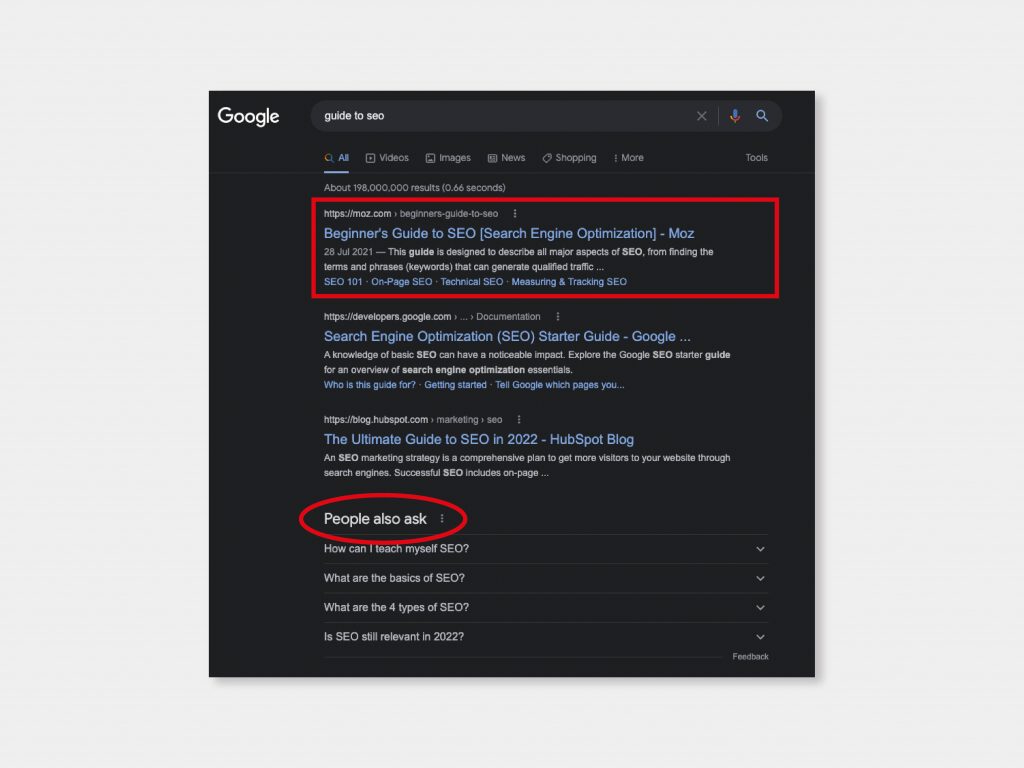
Most of your content marketing activities will lay under the informational intent queries. So, it’s quite important to optimise your content correctly. Make sure to use headings and structure your content in a way where it can be skimmed through, rather than read from start to finish. Take this blog as an example, the content is clearly structured with headings and is presented in short paragraphs answering various questions.
Another addition to your content can be – answering ‘People also ask’ questions or FAQs. The answers can be pulled out to SERPs directly and prove as a good source of additional traffic.
Navigational Intent
Navigational intent translates to a user searching for a specific website or an address to visit. Most often, the search queries include words like ‘website’ or ‘address’, while being accompanied by a brand/location name.
The key to understanding navigational intent is that users already know what they’re looking for. Google uses SERP to highlight the required information. For instance, if you’re looking for ‘Heathrow airport address’. The address will be displayed at the very top of the results page, as well as a Google Maps snippet on the side.
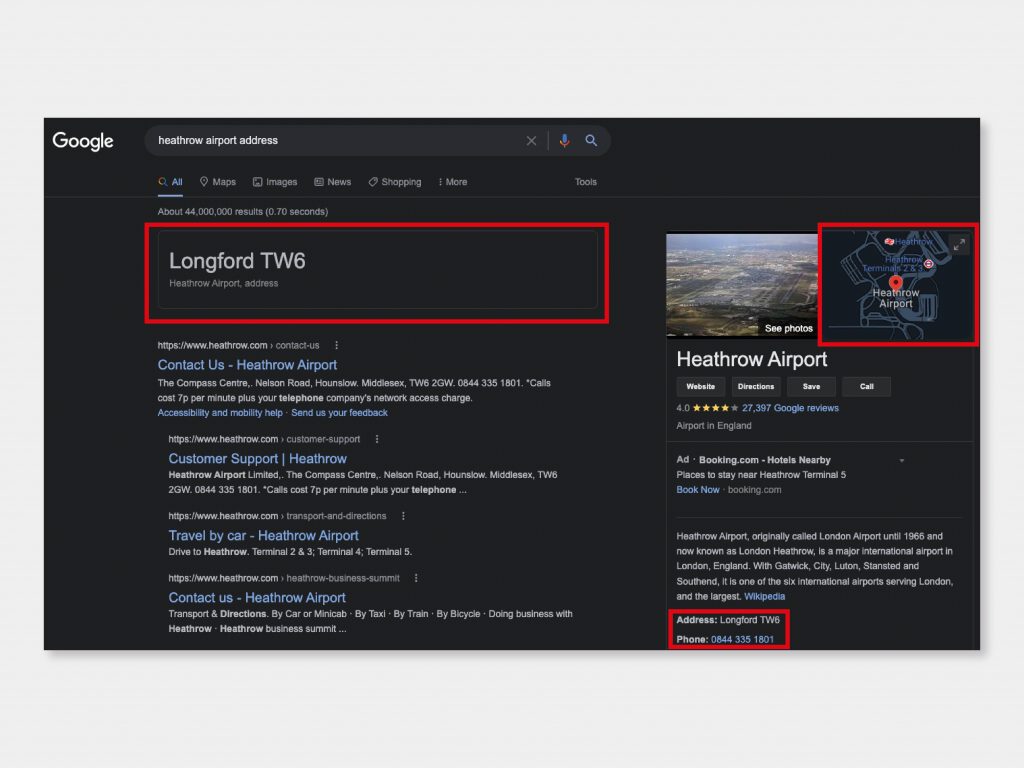
To take full advantage of navigational intent for your business, make sure your Google Business Profile (previously called Google My Business) is fully up to date. As well as, having easily accessible contact details on your website. It can also include having ‘customer service’ and ‘contact us’ web pages in place or any other FAQs regarding finding/contacting your business. This will allow users to frictionlessly find your contact details in the search engine itself.
Commercial Intent
Commercial intent covers queries that are made before completing a purchase. It’s usually a mix between information and transactional intent. The answers are still educating users but are more focused on specific products/services.
It’s all about explaining your offering & what information is needed for users to convert. Whether it’s reviews by 3rd party sources or articles comparing your products to competitors’ – they weigh in on the purchasing decision. In other words, you’re giving your audience that final push to buy by educating them.
Let’s take ‘best marketing agencies in the UK’ as an example. The search results are populated by locations, reviews, and various articles comparing top agencies in the country. Ideally, if a business owner is looking for an agency to hire – the results will point them in the right direction and eventually lead to a conversion.
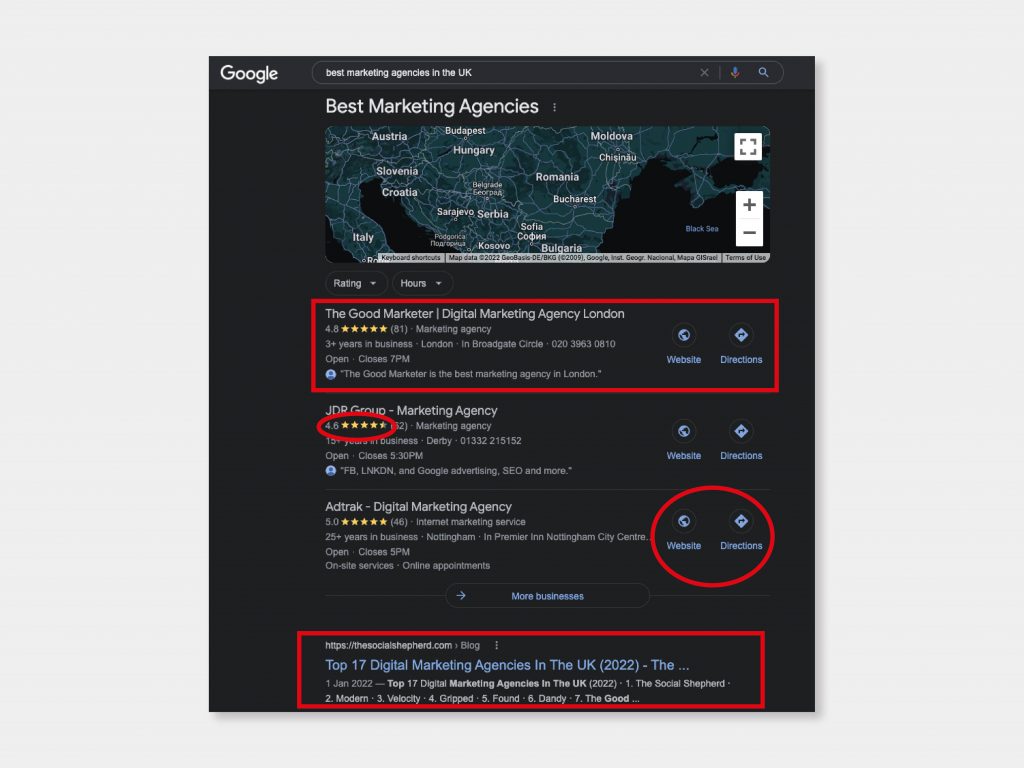
Transactional Intent
If a user is looking to complete a conversion, whether it’s to buy something online, visit a brick-and-mortar store, or sign up for an email newsletter – it’s considered transactional intent. It’s crucial for businesses to target these keywords since they’re surrounding the final stages of the buyer’s journey. In other words, this is what’s going to make your audience buy.
The transactional results tend to have the most important information surrounding products/services, filled with crystal-clear CTAs, and all the other conversion rate optimisation practices.
For example, ‘ps5 games’. You can clearly see all the newest/most popular games pop up at the top of search results. And if you click on any of those – you’re immediately moved to a landing page where you can buy the game directly.
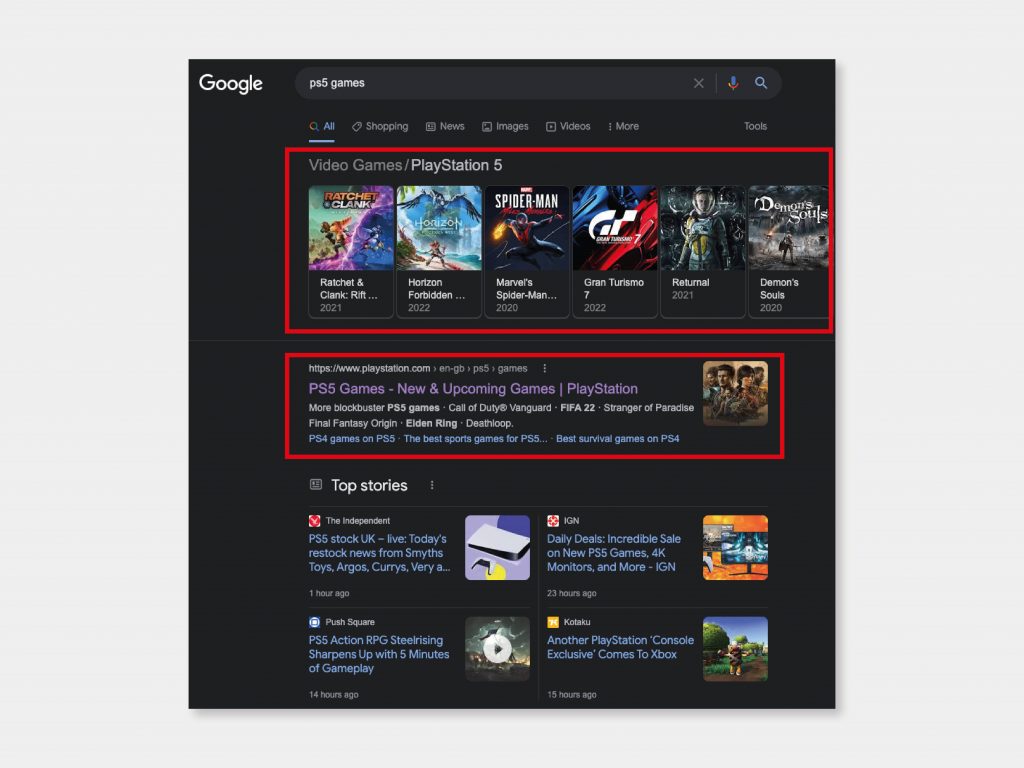
The key to understanding transactional intent is that people are already ready to buy and are aware of the products at least partially. The more popular queries may include words like, ‘buy’, ‘purchase’, etc.
How to identify search intent?
The easiest way to approach identifying search intent is to look at it from a marketing funnel perspective.
- Awareness – Informational Intent. This is where you can target keywords answering FAQs, creating evergreen content, and educational content. Raising your brand awareness.
- Consideration – Commercial intent. This part of buyer’s journey is all about aiming to produce content on product/service focused keywords. Compare your products to competition or get on the ‘best..’ lists. By doing this, you’re putting your business into buyer’s consideration.
- Conversion – Navigational or Transactional Intent. More focus should be put on brand related keywords. Make it as easy as possible to discover information about your offering, contact details, location where to buy from, etc. It’s all about making converting frictionless.
It is possible to determine intent yourself, depending on the context. Although, sometimes the search intent may be not as obvious or a bit misleading. In those cases, we fall back to SEMrush Keyword Magic Tool. Which assigns search intent for most keywords.
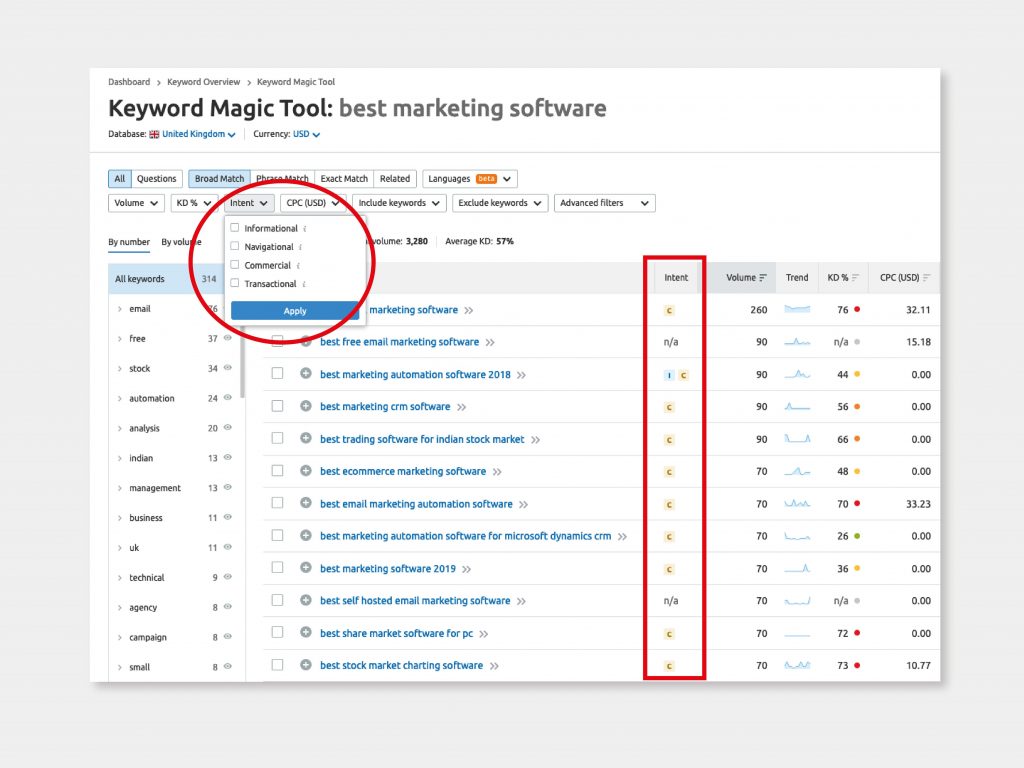
Key takeaways
All in all, search intent is crucial for any effective SEO strategy. Targeting keywords based on search intent will provide you with:
- Higher quality traffic
- Better conversion rate
- Lower bounce rate
- More featured snippets on search engines
- Wider & more accurate audience reach
Informational content should be focused on educating your audience. Commercial content allows the users to learn more about a product/service and form a decision. Transactional & Navigational content is all about assisting your audience in finding you, once they’re at the bottom of the sales funnel.



